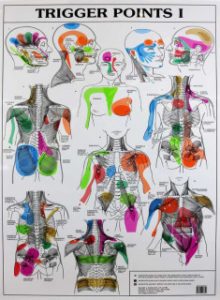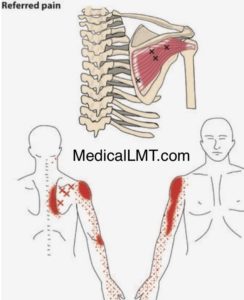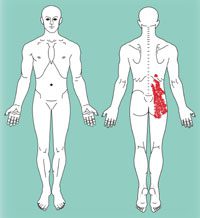Well - Halloween is fast approaching! As I was thinking about trick-or-treating, it made me think about the tricks that our body can play on us. So, for the month of October, I'm going to be covering the different ways that our body can trick us.
This week we're going to be talking about trigger points. You may have never heard of trigger points before, but you probably have felt them! When our muscles contract, the entire muscle does not contract all at once. If you start with your elbow straight and slowly bend your elbow, your bicep is one of the main muscles that does this action.
However, when you start to bend your elbow, the entire bicep muscle does not contract all at once. At first, the part of the bicep that's closest to your elbow is the only part that contracts, then slowly the middle portion of the bicep will contract, and then when your fist is up next to your shoulder, the upper portion of the bicep will be contracting.
This is how our muscles are supposed to work: Different sections contract depending on what our body is doing at that time - and then they relax when we stop moving that body part. At least that's how it's supposed to work. Sometimes little sections of our muscles will stay contracted even after we've stopped using that muscle. This tiny little section of muscle that remains in a contracted state is usually kind of hard to the touch. If you've ever felt a knot in a muscle, you're feeling a trigger point.

In this blog, I'm going to mention the different types of trigger points, trigger point pain referrals, and the three most common trigger point referrals I see in my patients that try to trick us about where the pain actually is.
There are two types of trigger points:
1) Active trigger points
2) Latent trigger points
If you're walking around and you feel a painful area in a muscle, that is an active trigger point. That means that it's painful at rest. But if you've ever had a massage, and when the massage therapist starts pressing on an area, you find that it's super tender and very painful, but it wasn't painful until they touched it, that is what's called a latent trigger point.
Trigger points are known to produce what is called referred pain. If you have ever heard of the symptoms of a heart attack, specifically the pain down the left arm, this is another example of referred pain. Referred pain is when one specific structure is irritated, but we actually feel the pain in other areas.

This can be extremely confusing, but it's very important to know if your pain is referred or not. Imagine if you went to the hospital with chest pain and left arm pain, and the nurses just started treating your left arm. You probably wouldn't have a very good outcome.
This is why it's important that your doctor is familiar with the concept of referred pain.
Otherwise valuable treatment time may be wasted on areas that are not actually irritated, but are just the location of referred pain.
The woman who first discovered trigger points created maps of trigger point referral patterns. These maps showed the areas where referred pain is felt for all the different trigger points in all of the muscles of the body.
The three most common trigger point referrals that I see in my practice are:
The gluteus medius muscles are located on the side of both hips. Trigger points in these muscles can send pain down the side and back of the thigh all the way to the back of the knee. Some doctors have called these trigger point referrals pseudo sciatica. Many people with trigger points in these muscles will actually think that they're having sciatica pain/issues, but really, it's just a trigger point.

Above you will see the trigger point referral map for the gluteus medius. It can cause pain around the low back or SI joint and all the way down the thigh to the knee. If you are having pain in these areas, I recommend you get assessed by a doctor who's familiar with trigger points.
__________________________
The infraspinatus muscle is on the back of the shoulder. However, the trigger point referral actually wraps around to the front of the shoulder. Sadly, I have seen patients who had surgery on the front of their shoulder - and their pain didn't change at all. It was only after treatment to the infraspinatus on the back of the shoulder that their pain went away.

Above you'll see the trigger point referral map for the infraspinatus. It can cause pain along the inner shoulder blade area, the front of the shoulder, and down the bicep. If you've had pain in these areas and maybe even have had some treatment with no help, make sure to see a doctor who's familiar with trigger points.
_________________________
And finally, there is the thoracic erector spinae. The erector spinae muscles are the muscles that run up the spine very close to the bones of the spine. These are the muscles that help us stand up tall. In the thoracic region or mid-back, trigger points in these muscles can actually refer pain to the low back and tailbone. I will often see patients who complain of low back pain and have had lots of adjustments to the low back and pelvis with no improvement. Once we treat the erector spinae, their pain goes away.

Above, you can see the trigger point referral map for the thoracic erector spinae. Interestingly, you can see that the pain referral map is almost completely in the low back. Meaning: You might not have any pain in your mid back, but that's actually where your problem is. These muscles can refer pain down to your low back tailbone and even the back of your hip. If this is a problem area for you - again - please make sure to see a doctor who's familiar with trigger points.
So there you have it, our body can really try to throw us for a loop. This is why it's always good, when you're in pain, to get a proper evaluation by a doctor who will look at all areas of the body and not just where you're hurting. This is something we do with every patient here at Movement Laboratory. If you're hurting and you suspect that you might have some referred pain going on or any other type of pain, give us a call at 918-300-4084 and we'll help you get out of pain fast!
Tune in next week when I'll discuss how some of our internal organs can cause pain all across our body!
